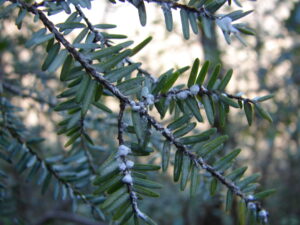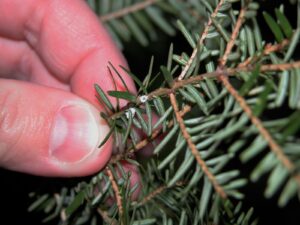By Linda Williams, Forest Health Specialist, Woodruff;
Linda.Williams@wisconsin.gov, 920-360-0665
Landowners with hemlock and anyone who walks through or works in hemlock stands can help watch for signs of hemlock woolly adelgid (HWA).
This invasive insect has not yet been identified in Wisconsin, but it has been found in seven counties in Michigan’s Lower Peninsula. The insect sucks the sap of hemlock trees, and large populations can cause the decline and mortality of hemlock over 4 to 10 years, depending on the health of the tree and population levels of HWA. It’s vital to find infestations as early as possible to allow multiple options for control and management.

To identify hemlock woolly adelgid infestation, look for white balls of fluff at the base of hemlock needles. / Photo Credit: Linda Williams, Wisconsin DNR
HWA has killed millions of Canadian and Carolina hemlocks in the eastern United States since its discovery in the region in 1951. HWA has been present in the western United States for even longer. However, the impact has been negligible as western and mountain hemlock trees have chemical defenses that protect them from being severely damaged or killed by this pest.
Although Michigan is surveying and treating infested trees with insecticides, HWA could appear in Wisconsin anytime. To reduce the chance of spread, Wisconsin’s hemlock woolly adelgid quarantine, known as ATCP 21.16, makes it illegal to bring hemlocks from infested areas into the state without a certificate verifying that the material is free from this pest or a compliance agreement that also requires importers to notify the Wisconsin Department of Agriculture, Trade and Consumer Protection (DATCP) and keep records of all incoming shipments from the infested area.
Do you know what to look for? HWA is typically present for multiple years before the population gets large enough to create visible indicators of their presence. HWA is most evident in winter and spring when fluffy, white, woolly balls are present as these insects feed at the base of hemlock needles. These fluffy, waxy balls cover adult female adelgids and eggs.

Light infestations of hemlock woolly adelgid can be difficult to spot, such as these two HWA insects on this branch. / Photo Credit: Linda Williams, Wisconsin DNR
You may also see hemlock foliage turning gray-green as tree health declines. Crowns will look thin as needles die and fall off prematurely. Tiny, immature crawlers may be visible as they move on infested tree needles. Still, you’ll need to look closely as they are small and might appear like the needle has been sprinkled with ground pepper. You may spot them already in place at the base of the needles as they find a place to feed. For information, including pictures of HWA, check out the Wisconsin Department of Natural Resources fact sheet and DATCP’s web page on the insect.
If you suspect you’ve found HWA in Wisconsin, please take some photos and immediately report your findings to your local DNR forest health specialist or DATCP, and avoid moving infested materials from the area. Prompt reporting can help agencies respond more quickly.
The Wisconsin Invasive Forest Pest Coordinating Group, which has members from the U.S. Department of Agriculture’s Animal and Plant Inspection Service, the Bureau of Indian Affairs, UW-Extension, the DNR, DATCP, U.S. Forest Service and the Wisconsin Tribal Conservation Advisory Council, is prepared to react if and when HWA arrives in Wisconsin.

A hemlock branch shows needles, old cones (top) and newly forming cones (bottom). Look for hemlock woolly adelgid on the undersides of branches at the base of the needles. / Photo Credit: Linda Williams, Wisconsin DNR
Wisconsin has already advocated for the continued availability of neonicotinoids, one of the few insecticides that can be injected into hemlock or applied as a soil drench where appropriate to protect high-value trees from HWA. The Invasive Forest Pest Coordinating Group will support biocontrol releases and other management or eradication actions if and when HWA should be detected.
